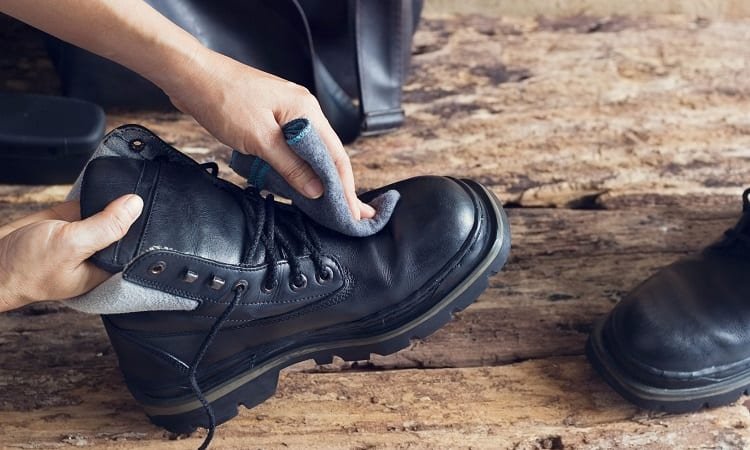HOW TO : Remove Mold from Leather Shoes
All of this rainy weather lately may be wonderful for the garden, but it has created some issues when it comes to the care and storage of our lovely leather shoes and boots. With the ground refusing to dry, the humidity levels have been rising in our wardrobe and storage boxes, leaving not just our shoes but handbags, belts and jackets vulnerable.
Have you just taken your favourite pair of winter boots out of storage only to discover that they have become the home to a thriving colony of mold? Don’t let this tempt you into throwing them away without first trying to save them. Here are a few tricks and tips that can help resurrect our beloved footwear and hopefully help prevent future mold breakouts.
What Causes Mold On Footwear?
Wherever there's excessive moisture, such as leaks, damp corners or wet insoles, mold can accumulate. Shoes are especially susceptible to mold growth. The dark, warm, moist environment of footwear creates the perfect lair for fungus to thrive.
Although they're quite luxurious, leather clothes, shoes, and accessories are prone to mildew and mold growth if they're stored in an area where moisture and heat levels are too high. It only takes one spore to start a colony, so it's important to remove mold from your belongings as soon as you spot it.
Mold on leather shoes is a common problem especially when humidity is high.
How To Remove Mold From Leather Shoes
There is more than one way to treat problem of mold and mildew on your shoes, but basically it comes down to four simple steps.
1: Clean
2: Sanitize
3: Restore
4: Prevent it from happening again.
Step 1: Clean
The very first step to removing mold is to take the shoes outside, since you don’t wont the mold spores to spread indoors, and wipe away all surface mold with a cotton cloth made damp with hot water. Do it carefully. Then let the shoes air dry, preferably outside. Please wear a face mask as you do this to prevent breathing in the spores.
Step 2: Sanitize
There are a number of different cleaning products you can use, but the cheapest and best is regular white vinegar. This is harsh on skin, use gloves to protect your hands. If you want to make the smell less harsh, you can mix the vinegar with lemon juice. The liquid should contain about 12% vinegar, so if it’s stronger, mix it with water to achieve a similar concentration. Again, do this outside. Dampen a cloth or a sponge with vinegar solution and wipe thoroughly over the entire shoe. Don’t miss the inside if there’s any trace of mold there as well. It’s important that you wipe the whole shoe so it will all become damp, to avoid water marks when the shoes dry again. Let air dry out of direct sunlight.
Another method is by using rubbing alcohol (isopropyl alcohol). In a clean container, mix equal parts cool water and rubbing alcohol. Use a clean white cloth dipped in the mixture to wipe down the leather, using a cotton swab to clean crevices. Finish by wiping the leather with a clean cloth dipped in water.
Baking soda is a mold and mildew killer, and can be used to clean leather without damaging it. It's also a great option for white leather because it won't stain it. Sprinkle baking soda on any leather surface and vacuum it after about 20 minutes, or until the baking soda is completely dissolved.
Step 3: Restore
Once all the mold has been removed and the shoes are completely dry, the leather may be quite stained and dried out, and in serious need of conditioning. First apply one or two layers of a good conditioner, preferably a conditioning leather lotion. Next apply at least two thin layers of a good quality shoe cream, and if you wish you can go on with a shoe wax as well. If possible use a coloured polish to even out the colour of the leather. All this will help to restore the shoes even further.
Because it only takes a single mold spore to begin the molding process all over again, if necessary replace shoe laces and give your storage area good clean and sanitize.
If all this is done properly the shoes should be back in a good condition again within a few hours. Should you not be able to solve the problem yourself, take the shoes to a good cobbler or leather restorer.
Step 4: Prevention
When you’ve been out in heavy rain and your shoes are soaking wet, extra care needs to be taken to reduce the risk of mold and mildew.
Start by wiping the shoes with a damp dish cloth or similar to remove any dirt and residues.
Leave them dry in an airy place, ideally outside if weather permits, or by an open door. Don’t be tempted to try and dry them faster by using direct heat, such as a heater or beside the fireplace or similar. The heat will stress and dry the leather massively and may even cause the leather to crack.
Make sure that air can circulate around the shoes, leave them laying on the side, standing on a non-even surface which lets air through, or by hanging them up.
Silica gel packs can also be used inside your shoes or spread around your shoe cupboard or even inside your shoebox. The use of silica gel is widespread and diverse mainly because it is a nearly harmless, cheap, and easy mold prevention method. It is recommended to use silica gel bags in an enclosed environment.
Humidity is one crucial factor that promotes mold growth. Thus, getting a dehumidifier can prevent shoes from molding. This device reduces humidity from the surrounding air. In other words, it is one way to reduce excessive moisture in the air.

